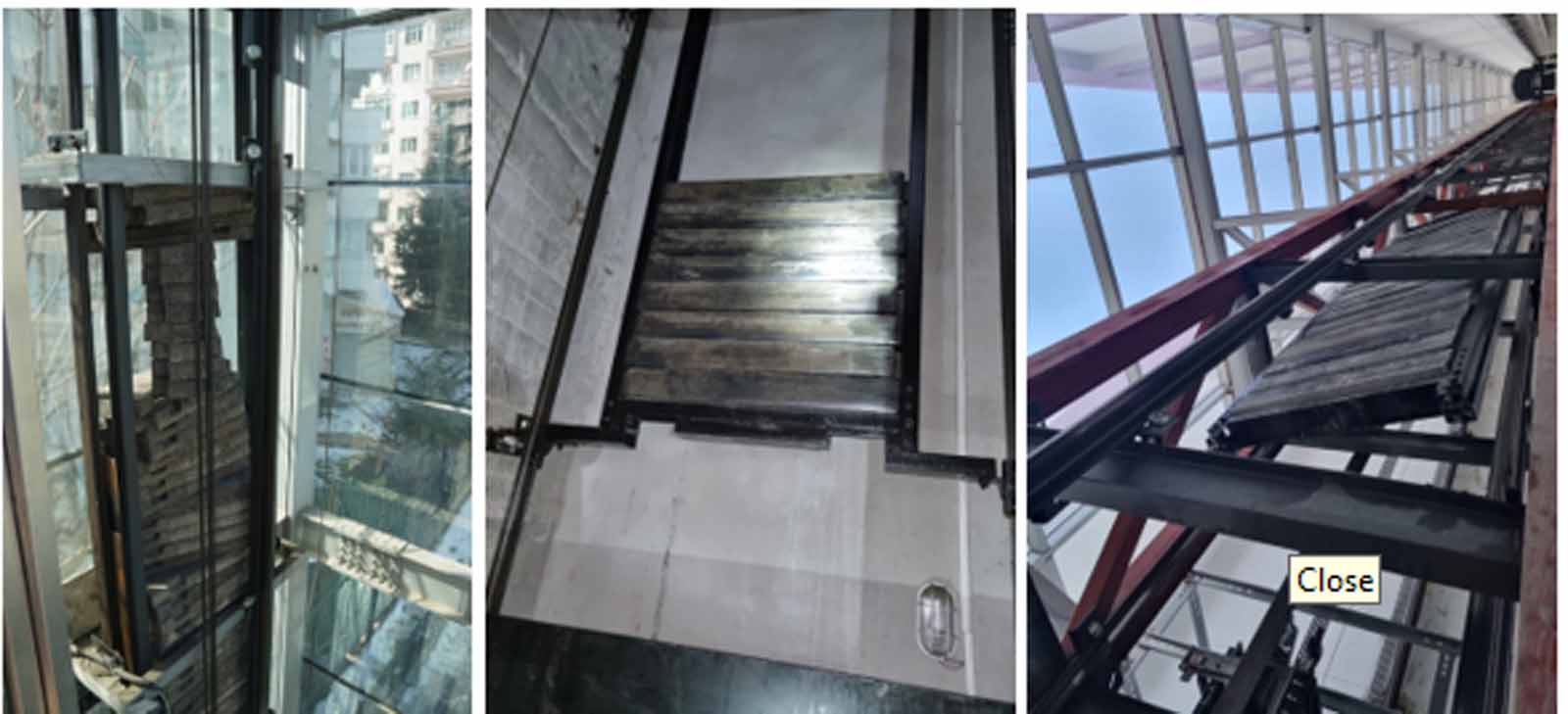A Field Study on the Damage of Elevators After the Twin Earthquakes
Jun 1, 2024

A look at the damages and what needs to be done to prevent this in the future
by Ferhat Çelik, C. Erdem İmrak and Sefa Targıt
This paper was presented at Elevcon 2023 in Prague, Czech Republic.
Key Words: Earthquake, elevator, hazard, EN 81-77 standard
Abstract
Elevators are widely utilized for vertical transportation of people and goods in buildings. In many recorded earthquake events in the past, a considerable amount of damage in elevators was observed. There is a considerable stock of elevators in the seismic risk zones of Türkiye. Any building in a seismic risk area should be designed to withstand the earthquake shocks. In this study, after a one-day field study conducted by AYSAD (Turkish Elevator and Escalator Association) in and around Malatya after the twin earthquakes, an evaluation of the damages detected in the examined elevators and the current situation was included.
1. Twin Earthquakes in Türkiye
Lift systems are adversely affected by earthquakes. The elevators and hoistways in seismic risk zones require certain additional considerations over normal installation practices, as indicated in the EN 81-77:2013 standard.
Türkiye is a seismically active area within the complex zone of collision between the Eurasian Plate and both the African and Arabian Plates. The most well-known and important seismic hazard in Türkiye is the North Anatolian Fault. The East Anatolian Fault, which runs southwest from eastern Türkiye to the Mediterranean, is another well-known source of large earthquakes.
Major losses of life and property due to destructive earthquakes have pioneered the development of earthquake-resistant building design principles. The Türkiye seismic hazard map is depicted in Figure 1 (AFAD, 2018).

1.1 The 1999 Izmit Earthquake Near Istanbul
One of the strongest earthquakes of the century killed approximately 20,000 people, destroyed approximately 15,500 buildings, caused nearly US$10-25 billion damage and occurred in northwestern Türkiye at the eastern extension of the Sea of Marmara on August 17, 1999. The earthquake’s epicenter was located about 105 km east of Istanbul, an urban center of more than 10 million people near the town of Izmit on the North Anatolian fault. The earthquake measured 7.5 moment magnitude (Mw) on the modified Richter scale. The earthquake was followed by hundreds of aftershocks (Ozkirim & İmrak, 2004). Unfortunately, since field studies were not carried out in the earthquake zone after the 1999 Izmir earthquake, damage to the elevators in the region was not evaluated.
1.2 The 2011 Van Earthquakes
A very strong damaging earthquake occurred in the Van Province in Eastern Türkiye at a magnitude of 7.2 Mw and was felt in all the neighboring countries. The Van earthquake, which occurred on October 23, 2011, at 13:41 local time, has been modeled based on far field waveform recordings. As many as 8,321 homes were left uninhabitable with an average household population of around 7.6 in the province; that is, around 63,000 people were left homeless. The death toll was caused primarily from building collapse in urban areas (Imrak & Çelik, 2014). After three days (December 25-27, 2011) of investigation of the lifts in Erciş, Edremit and the city center of Van, a survey report containing the type of lifts, the type of damage and photographic evidence was published (Imrak, 2012a, 2012b, 2013). In total, 25 elevators were examined and reported.
1.3 The 2023 Twin Earthquakes Near Kahramanmaraş
An earthquake with 7.8 Mw hit southern and central Türkiye on February 6, 2023. The epicenter was 37 km west-northwest of Gaziantep. It was followed by a 7.7-Mw earthquake. This earthquake was centered 95 km north-northeast from the first.

There was widespread damage and tens of thousands of fatalities. In an area of about 350,000 km2, the two devastating earthquakes struck Türkiye, killing more than 50,000 people and injuring thousands. The 7.8- and 7.5-magnitude earthquakes also destroyed critical infrastructure, leaving the communities in the area in urgent need of humanitarian assistance. The massive twin earthquakes that struck southern Türkiye on February 6 caused great destruction in an area of the Kahramanmaras province.

An estimated 14 million people, or 16% of Türkiye’s population, were affected. It is the deadliest earthquake in what is present day Türkiye since the 526 Antioch earthquake. According to the Kandilli Observatory, the maximum MMI of the mainshock was estimated to have reached MMI XI–XII (Extreme) in Antakya and near the epicenter.
2. Field Study and Results in Malatya
On February 6, 2023, affecting a total of 11 provinces in the Southeastern and Eastern Anatolian regions, Ekinözü-Kahramanmaraş (38.0818 N, 37.1773 W) had an instrumental magnitude of Ml=7.5 (Mw=7.7) at 04:17 local time at the epicenter, and then Sofalaca-Şehitkamil-Gaziantep (37.1757 N, 37.085 W) at 13:24 local time at the epicenter, the instrumental magnitude of Ml=7.4 (Mw=7.6) after two very severe earthquakes. A field study was conducted by AYSAD in the province of Malatya.
In Malatya, one of the provinces affected by the earthquake, it was a priority target to determine and document the condition and damage of elevators and components in hospitals, residential buildings and factory buildings that were slightly damaged and could be entered, and to transmit this to the relevant institutions and organizations in the form of a report.
The AYSAD delegation checked the elevator wells, rail connections, machine rooms, machinery, cars and counterweight components in the buildings and determined the behaviors exhibited by these components during the earthquake.
Due to continuing aftershocks in the region, ongoing intensive rescue and relief efforts and having limited access permits to the buildings, a limited number of buildings and elevators were examined during a one-day site visit.
| No. of Stops | No. of Units |
| 2 stops | 2 |
| 3 stops | 2 |
| 4 stops | 1 |
| 5 stops | 2 |
| 6 stops | 6 |
| 10 stops | 1 |
| 14 stops | 1 |
| 17 stops | 1 |
| Total units | 16 |
Table 1: Number of elevators stops
Based on this explanation, only 16 elevators were examined, and the distribution of elevators according to the building heights (number of stops) is shown in Table 1. Including these, a hydraulic-driven disabled platform was also examined.
The types of elevators studied in Malatya are given in Table 2. It was aimed to examine as many different types of elevators as possible, but the risk of aftershocks and entering buildings was taken into account. Among the examined elevators, there is one overpass elevator and one panoramic elevator apart from in the university hospital, wherein multiple elevator machines were examined in a large attic, and one of the low-rise buildings machine-rooms could not be inspected.
| Elevator Type | No. of Units |
| Makine daireli | 6 |
| Machine-room-less (MRL) | 8 |
| Hidrolik | 2 |
| Total units | 16 |
Table 2: Investigated elevators in Malatya
The distribution of the elevators examined according to the landing door type and capacity is shown in Table 3.
| Capacity | No. of Units | Type of Doors | No. of Units | |
| 8 person | 630 kg | 4 | Center opening | 9 |
| 10 person | 800 kg | 10 | Side opening | 4 |
| 21 person | 1600 kg | 2 | Single hinged | 3 |
Table 3: Variation of elevators according to door type and capacity
From the examination of elevators in general, it can be said that almost all of them were not designed and installed in accordance with the EN 81-77 standard. In particular, it has been observed that the sheet metal combination brackets are not specially designed for earthquake zones, and many of them have structural damages caused by the effects of the earthquakes (Figure 4).

During the site visit, it was observed that the elevators in which the fire and seismic sensors were installed were located only in the university hospital building. After the earthquake, it was observed that the sensors were activated and performed their tasks. However, resetting of the seismic sensor could not be performed due to the lack of organization/competence of the elevator maintenance service.
While there was damage to the landing doors of the MRL elevators and their surroundings during the hospital visit made after the Van earthquake, there was no damage to the landing doors of different working styles during the visits made in Malatya.
Although the counterweights of the elevators are composed of concrete blocks, there was no damage if the counterweight was displaced and fell to the elevator car top or well amongst the observed elevators. However, counterweight damages are the most commonly observed damages where concrete blocks are cracked, displaced within the steel frame and counterweight shoes are damaged (Figure 5).
The damaged components of elevator installations from this earthquake are listed as follows:
- Counterweights out of their rails and some collided with the cars
- Hoisting ropes damaged or out of their sheaves
- Rail brackets broken or damaged
- Governor cable hung up
- Roller guides shoe broken or loose
- Compensating cables out of their grooves or damaged
- Some hoistways collapsed and cars buried at the bottom
All of the damages listed above have been observed in rope-driven elevators. Only two hydraulic elevators could be examined in the field. It was determined that these elevators worked smoothly when energized (Figure 6). No observation of damage to hydraulic elevators was made during the investigation after the Van earthquake.

To ensure minimal damage to elevator systems in the event of an earthquake, the following countermeasures should be taken:
- Seismic switches that utilize seismic energy to actuate useful functions
- Measures for the counterweight such as box brackets, tie rods, electrically charged wire with displacement ring
- An adequate size guide rail
- Roller guide assembly
- Retainer plate
- Structural support frames for seismic isolated buildings
- Other protective measures such as rope guards and anti-snag guards
3. Discussions and Conclusion
EN 81-77 specifies the special provisions and safety rules for passenger and goods passenger lifts where these lifts are permanently installed in buildings that are in compliance with EN 1998-1 (Eurocode 8) and defines additional requirements to EN 81-20 and EN 81-50.
The EN 81-77 standard had begun to be applied in Türkiye in 2014 after the Van earthquake in 2011. The calculation and design elements explained in this standard were not present in the elevators examined in the field after the Van earthquake. This standard was revised in 2020 and 2022 and entered into force in Türkiye.
In the years after the 1999 Izmir earthquake and the 2011 Van earthquake, it was expected that the EN 81-77 standard was used for elevators installed in earthquake-risk areas. However, unfortunately, the same structural deficiencies and non-application of the EN 81-77 standard were encountered in the elevators installed in buildings in the seismic zone after the twin earthquakes of 2023.
Hydraulic elevators that do not have a counterweight and are durable with their shake-absorbing cylinder structure can be more conveniently utilized in low-rise buildings in seismic regions.
References
1. AFAD (2018). Türkiye Deprem Tehlike Haritaları İnteraktif Web Uygulaması (Türkiye Earthquake Hazard Maps Interactive Web Application). Ministry of Interior of Türkiye Disaster and Emergency Management Presidency (AFAD). tdth.afad.gov.tr
2. CEN (2022). Safety rules for the construction and installations of lifts – Particular applications for passenger and goods passenger lifts – Part 77: Lifts subject to seismic conditions. EN 81-77.
3. İmrak, C. E. (2012a). A Survey for the Effect of 2011 Van Earthquakes on Elevators. Elevator World 59(6), 40-45.
4. İmrak, C. E. (2012b). The effects of the Van earthquakes on lifts. Elevatori 41(6), 44-65.
5. İmrak, C. E. (2013). A Survey for the Effect of 2011 Van, Türkiye, Earthquakes on Elevators. Elevator World India 6(1), 34-39.
6. İmrak, C. E., and Çelik, F. (2014). Effect of 2011 Van earthquake on the elevators. Proceedings of ELEVCON 2014, Paris, 114-124.
7. International Medical Corps (2023). Syria/Türkiye Earthquakes Situation Report #7, March 8, 2023.
8. International Blue Crescent Relief and Development Foundation (2023), Kahramanmaraş Earthquakes, Situation Report #20, April, 6, 2023.
9. Ozkirim, M, and İmrak, C. E. (2004). Countermeasures for elevators in the seismic risk zone of Istanbul. Proceedings of ELEVCON 2004, İstanbul, 18-19.
Get more of Elevator World. Sign up for our free e-newsletter.









